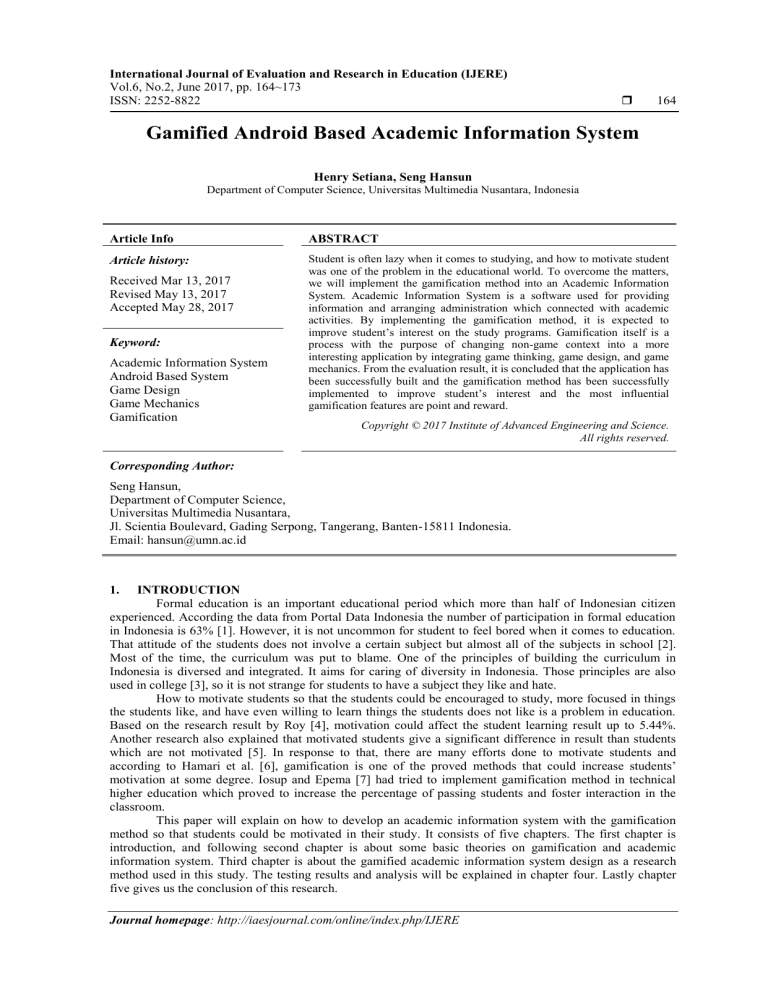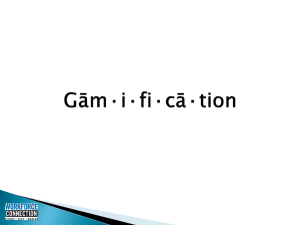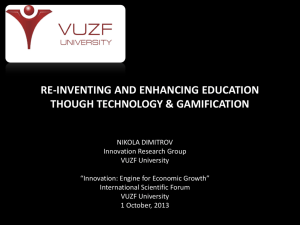
International Journal of Evaluation and Research in Education (IJERE)
Vol.6, No.2, June 2017, pp. 164~173
ISSN: 2252-8822
164
Gamified Android Based Academic Information System
Henry Setiana, Seng Hansun
Department of Computer Science, Universitas Multimedia Nusantara, Indonesia
Article Info
ABSTRACT
Article history:
Student is often lazy when it comes to studying, and how to motivate student
was one of the problem in the educational world. To overcome the matters,
we will implement the gamification method into an Academic Information
System. Academic Information System is a software used for providing
information and arranging administration which connected with academic
activities. By implementing the gamification method, it is expected to
improve student’s interest on the study programs. Gamification itself is a
process with the purpose of changing non-game context into a more
interesting application by integrating game thinking, game design, and game
mechanics. From the evaluation result, it is concluded that the application has
been successfully built and the gamification method has been successfully
implemented to improve student’s interest and the most influential
gamification features are point and reward.
Received Mar 13, 2017
Revised May 13, 2017
Accepted May 28, 2017
Keyword:
Academic Information System
Android Based System
Game Design
Game Mechanics
Gamification
Copyright © 2017 Institute of Advanced Engineering and Science.
All rights reserved.
Corresponding Author:
Seng Hansun,
Department of Computer Science,
Universitas Multimedia Nusantara,
Jl. Scientia Boulevard, Gading Serpong, Tangerang, Banten-15811 Indonesia.
Email: hansun@umn.ac.id
1.
INTRODUCTION
Formal education is an important educational period which more than half of Indonesian citizen
experienced. According the data from Portal Data Indonesia the number of participation in formal education
in Indonesia is 63% [1]. However, it is not uncommon for student to feel bored when it comes to education.
That attitude of the students does not involve a certain subject but almost all of the subjects in school [2].
Most of the time, the curriculum was put to blame. One of the principles of building the curriculum in
Indonesia is diversed and integrated. It aims for caring of diversity in Indonesia. Those principles are also
used in college [3], so it is not strange for students to have a subject they like and hate.
How to motivate students so that the students could be encouraged to study, more focused in things
the students like, and have even willing to learn things the students does not like is a problem in education.
Based on the research result by Roy [4], motivation could affect the student learning result up to 5.44%.
Another research also explained that motivated students give a significant difference in result than students
which are not motivated [5]. In response to that, there are many efforts done to motivate students and
according to Hamari et al. [6], gamification is one of the proved methods that could increase students’
motivation at some degree. Iosup and Epema [7] had tried to implement gamification method in technical
higher education which proved to increase the percentage of passing students and foster interaction in the
classroom.
This paper will explain on how to develop an academic information system with the gamification
method so that students could be motivated in their study. It consists of five chapters. The first chapter is
introduction, and following second chapter is about some basic theories on gamification and academic
information system. Third chapter is about the gamified academic information system design as a research
method used in this study. The testing results and analysis will be explained in chapter four. Lastly chapter
five gives us the conclusion of this research.
Journal homepage: http://iaesjournal.com/online/index.php/IJERE
IJERE
ISSN: 2252-8822
165
2. THEORETICAL BASIS
2.1. Gamification
Gamification is a process that aims to change a non-game context (example: learning, teaching,
marketing) becomes much more interesting by integrating games thinking, game design and game mechanics
(game elements) [8],[9]. The use of gamification is very effective to create a work that is usually tedious,
unpleasant, or less challenging becomes much more fun to do (example: filling out surveys, fill out a tax
accreditation, writing paper, and many more). One approach that can be done is by providing an appreciation
both virtual and non-virtual that can encourage someone to do “better” than others [8].
Gamification implements the dynamics and mechanics of psychology that makes the game
challenging and addicting. It is a technique to provide information into the system and facilitate processes
that spur such sharing type [10]. Gamification is meant to be implemented on non-gaming applications, such
as enterprise business application, collaboration and communication application suites, and also learning
applications. Figure 1 describes the elements of gamification, such as [10]:
1. Game Design
The way application needs logic, games are also internal logic in mind. In case, games do warning, it
fails to engage the user for a long.
2. Behavior
High-end user engagement to influence the target behaviors level depends on the type of the game
players Behavior.
Achiever - who are focused on game-oriented goals.
Explorer - who are innovative and love to find hidden part of the game.
Socializers - who mainly focused in engaging and sharing with other user.
Killers - who always want to create trouble with other user.
3. User Experience
Most interaction design is about process and knowledge worker efficiency where “Gamefulness” and
“Playfulness” attributes are important in user experience design.
Figure 1. Gamification Concept [10]
2.2. Key Elements in Gamification
Gamification has some use cases for successful application in social media. Now it has become an
innovative way to motivate people with the game mechanics [10].
The architecture of gamification essentially based on key elements such as [10],[11].
1. Rewards and Incentives
In order to remain competitive, an organization usually provides gifts and incentives to its members.
2. Badges
Gamification technique when linked with social features used medals or badges to show different levels
of achievement when certain milestones are reached.
3. Leaderboards
By dividing the job into several parts based on domains and areas in the leader board, it can help people
to know where they were supposed to be on his community so that competition can be built.
Gamified Android Based Academic Information System (Henry Setiana)
166
4.
5.
6.
7.
ISSN: 2252-8822
Point and Score
In addition to giving gifts and incentives a game also can provide points that can provide the possibility
of obtaining the prize. In giving points there are some things that are taken into account such as: the
ability to respond rapidly, the level of participation, the quality of the results.
Competition
Competition is something that can describe a situation in which success can be calculated from the
results of achievement. In the competition a player will try to beat the other players, but in game design
is usually made into a match between teams.
Social Connection
Games today cannot be separated with a social media where players can share information, help each
other, or compete in a game.
Level and Reputation
Everyone needs a degree of satisfaction in achieving a goal. In gamification it could be made more
concrete and visible to others through a level value and reputation. It becomes a gift that gives a sense of
high achievement for users.
2.3. Academic Information System
Academic is a field that studies on the curriculum or learning in its function to increase the
knowledge in terms of education or learning, can be managed by a school or educational institution [12].
While information system refers to both the system that delivers information and communication services to
an organization, and the organization function that plans, develops, operates, and manages the information
systems [13].
Academic Information System is software which is used to present and organize information related
to the administration of academic activities. With the use of software, academic administration activities is
expected to be managed properly and the required information can be obtained easily and quickly [14].
Through the Academic Information System (AIS) that students can see the grade, finance, and also the
absence list of the students as well as other data related to the students' academic record. The data presented
may vary between academic bodies with one another, but most of the data presented is generally the same
and follows existing standards [14].
3.
RESEARCH METHOD
To build a system with gamification methods, the game mechanics needs to be set first. Game
mechanics used in this study are as follows.
1. Level and Experience
Experience (exp.) and level system applied to the assignment system built. Experience will be given
when the student completes an assigned task. When experience earned reach a certain point the student
level will rise.
2. Badges (Achievement)
Badges on the system are given to the user when the user reaches a certain stage in the application. There
are three things that are taken into account in the granting of badges, the level of users, number of events
that followed, and the number of tasks completed. In total there are nine badges which can be obtained
by users.
3. Leaderboards
Leaderboard implemented in two parts, a class ranking which is based on the value of each subject and
the overall ranking of students based on level.
4. Point and Reward
In addition to gain experience, when completing the task, students are also given points that can be
exchanged for rewards that have been provided. This feature is created so that students can obtain
directly visible when completing tasks.
5. Social Connection
Games nowadays cannot be separated with a social media. In the development of this system, we
implement a feature to search and view the profiles of other students to support social features.
For the design of user interfaces, the applications used flat design with colors that resemble colorful
modern game in which mostly have a simple display but still interesting. Some screenshots of the application
that has been built are shown on Figure 2 to Figure 6 to explain the results of the application design and
development.
IJERE Vol. 6, No. 2, June 2017 : 164 – 173
IJERE
ISSN: 2252-8822
167
Figure 2. Login and Student Main Menu Pages
Figure 3. Student Score Ranking and Quest Detail Pages
Figure 4. Level Up Notification
Gamified Android Based Academic Information System (Henry Setiana)
168
ISSN: 2252-8822
Figure 5. Profile and Badges Pages
Figure 6. Social and Rewards Pages
4.
RESULTS AND ANALYSIS
This part explained about the results of the system testing. The results are based on questionnaire
result of 30 respondents which had tested the application. Here is the result of each questionnaire questions.
1. Respondents Data
After data recollection, we earn that respondents age ranged from 19-23 years old and are student of
Universitas Multimedia Nusantara.
2. Gamification Implementation
Based on data counting, 27 from 30 respondents answered different sensation when using the
application. From those 27 respondent, 23 respondent answered they feel like playing a game. From
those result it can be converted to a percentage, therefore we get a result of 76.6% from the respondents
feel like playing a game.
3. Users Motivation
Aside from gaming feeling, the questionnaire also asked about how the respondents motivation effected
by the implemented gamification.
After calculation, it is showed that 27 of 30 respondents said that they will be motivated if the system is
applied. Some respondents who do not get the feeling of playing games, still answered that they will be
motivated by the features of gamification applied to the system. In percentage terms, it was found that
90.00% of respondents are likely to be motivated. This proved that gamification is well accepted in
university students as the respondents were young people of age 19-23.
IJERE Vol. 6, No. 2, June 2017 : 164 – 173
IJERE
4.
ISSN: 2252-8822
169
Feature Comparison
To determine which features are most influential, the questionnaire also included about the ranking order
of features effect on motivation. Influence calculated by giving points to the features according to the
order of assessment, first place gets 5 points. The second position gets 4 points, third place gets 3 points,
fourth place gets 2 points and fifth gets 1 point. Based on calculations it is known that the most
influential feature is ‘points and rewards’ feature. Details are displayed in Figure 7.
Figure 7. Feature Comparison Graph
5.
Level and Experience Feature Influence
One of the implemented features into the system gamification is level and experience. To determine the
influence of this feature in academic information systems that are built, it will be analyzed based on the
Likert scale that has been listed in the questionnaire. The respondents will answer how much influence
the features of experience and level in the motivation of the respondent by providing the numbers 1 to 5.
Number 1 indicates that the feature does not affect the motivation, while the number 5 signifies that the
feature greatly affect the motivation. The Likert values obtained is 117 points with a maximum value of
150, when converted to a percentage the result is 78%. The result means that this feature is giving an
effect to the audience but the effect is still limited. It is most likely due to the short testing period that
makes the audience cannot reach a certain level that can give The calculation results can be seen in the
diagram in Figure 8.
Figure 8. Level and Experience Influence Chart
6.
Achievement Feature Influence
Based on the analysis in Figure 9, it appears that the answer tends to fall on option number 3, followed
by the number 4 and number 5. From the percentage using Likert calculations can be concluded that
71.3% of respondents are motivated by the achievement features.
Gamified Android Based Academic Information System (Henry Setiana)
170
ISSN: 2252-8822
Achievement Influence
1 2
Score 1
6
Score 2
12
9
Score 3
Score 4
Figure 9. Achievement Influence Chart
7.
Point and Reward Feature Influence
Using the same calculation with the previous two influences, the questionnaire also included questions
about the influence of point and reward feature using the Likert scale. Calculation Results can be seen in
Figure 10. After calculating the percentage, obtained 88.66% respondent motivated. From the results of
the percentage that fell at intervals of 80%-100% it can be concluded that the respondents feel very
motivated by the feature of point and reward. This feature is giving the highest influence rate. It is most
likely due to the instant benefit received by the respondents when achieving a certain milestones. It can
be said that by giving a certain reward or recognition to student in their study give the highest influence
to their motivations.
Point and Reward Influence
0 0
Score 1
6
Score 2
5
19
Score 3
Score 4
Figure 10. Point and Reward Influence Chart
8.
Leaderboard Feature Influence
The questionnaire also included questions about the influence of the leaderboard features using a Likert
scale. The percentage level is 74% of the respondents found motivated. Based on the percentage value
can be concluded that leaderboard feature has quite an effect on student motivation, although not
maximal. Results of calculation can be seen in Figure 11.
Leaderboard Influence
0
7
Score 1
3
Score 2
10
10
Score 3
Score 4
Figure 11. Leaderboard Influence Chart
IJERE Vol. 6, No. 2, June 2017 : 164 – 173
IJERE
9.
ISSN: 2252-8822
171
Social Feature Influence
The questionnaire also included questions about the influence of social features using a Likert scale.
Based on the analysis results, it was obtained that 70.06% of respondents were motivated. Results of
calculation can be seen in Figure 15. This feature give the lowest result and most likely is due to limited
social system and short testing period making the feature is less exposed to the respondents.
Figure 12. Social Feature Influence Chart
10. Data Correlation
Comparing the result data on Figure 7 with individual feature influence level, the influence ranking of
the features has the same ordering. Point and reward feature has the highest influence with 108 point in
feature comparison and 88.66% of influence to the audience, while the social feature has the lowest rank
with 51 point in the feature comparison and 70.06% of influence. This is most likely due to the short
testing time been taken in the experiment.
11. Discussion
In contrast with other research of gamification in eduction that bring negative result [15], in our
finding the most influential feature is the reward feature. While in their research [15] Hanus and Fox
highlight that Gamified systems that strongly featuring rewards may have negative effects on the long run,
our research actually give different results. This might due to difference in culture of the respondent and the
fact that our test duration is short term. But from this we can conclude that reward feature still can give
positive result to audience and that a further research might be necessary.
Similar with other research in western education system [16],[17], we found that gamification is also
correlated with participation in voluntary activities and assignments in local education system of Indonesia.
Though this time we yet to research the correlation between gamification with the passing students, other
research have concluded that higher motivation relate to higher education score and achievement [4],[5].
Based on that fact, gamification seems to be giving positive effect on student score and achievement too.
While the research results give positive effects, the result is heavily relate with the context where the
gamification method is implemented into, in this case an academic information system and its respondents.
As stated in the conclusion made by Hamari et al. [6] we agree that the result is very dependent with our test
case. As such, the age group of the respondents has a huge effect on the result given. We believed that our
respondents which ranged in age group of 19-23 can have the most positive effects in gamification. Similarly
other researcher also stated in his research that the effect of gamification is decline with age [17]. Although
the research gives a positive result, it is still a fact that the gamification system effects may vary from person
to person. As such just like what stated by Dicheva et al. [18], more empirical research might be needed to
accurately determine the effect of gamification.
5.
CONCLUSION
Based on the results of this study, it can be concluded that the application of academic information
system with gamification method has been successfully designed and built. It is also concluded that the
gamification features applied could motivate the students, while the effect is not significant. Only one of the
features that have a significant impact which is ‘point and reward’ feature. This is presumably because the
space scope is too broad therefore the applications built could not deliver maximum results.Through our
finding, gamification seems to match naturaly with younger generation lifestyle thus creating a positive effect
in their education.
Gamified Android Based Academic Information System (Henry Setiana)
172
ISSN: 2252-8822
In addition, through this research we found that gamification is also correlated with participation in
voluntary activities and assignments in local education system of Indonesia. Based on that fact, we conclude
that gamification seems to be giving positive effect on student score and achievement too.
Further research should improve implemented game elements, changing the design of the display to
make it more resembles a game and add more interesting features. It is also recommended to develop
applications with gamification method which is more focused, such as the application of learning in a certain
subject. Another research to further develop the gamified academic information system to campus
information system also could be done.
REFERENCES
[1]
[2]
[3]
[4]
[5]
[6]
[7]
[8]
[9]
[10]
[11]
[12]
[13]
[14]
[15]
[16]
[17]
[18]
Portal Data Indonesia, “School Enrollment Rate,” 2014. Retrieved on August 8, 2016, from
http://data.go.id/dataset/angka-partisipasi-sekolah/resource/ec623fcc-f4b1-43e6-8d52-2b371d2a5f3a.
R. Widiharto, “Mathematics Learning Models for Junior High School (SMP),” Yogyakarta, PPPG Matematika,
2004.
Tim Pengembang Ilmu Pendidikan FIP-UPI, “Education Science and Applications 1: Theoretical Education
Sciences,” Bandung, PT. Imperial Bhakti Utama, 2007.
A. R. Rahman and Slamet, “The Effect of Motivation, Environment, and Discipline Againts Student Achievement
in Audio Video Engineering Department of SMK Negeri 3 Yogyakarta,” Jurnal Elektronik Pendidikan Teknik
Elektonika, vol/issye: 1(3), pp. 1-21, 2012.
A. Kumala, “The Effect of Student Learning Strategy and Motivation Againts Learning Outcomes of Management
Information System Course in STMIK TIME-Medan,” Thesis, Medan, Universitas Negeri Medan, 2005.
J. Hamari, et al., “Does Gamification Work? - A Literature Review of Empirical Studies on Gamification,” 47th
Hawaii International Conference on System Science, Waikoloa, pp. 3025-3034, 2014.
A. Iosup and D. Epema, “An Experience Report on Using Gamification in Technical Higher Education,” 45th ACM
Technical Symposium on Computer Science Education (SIGCSE ’14), Atlanta, USA, pp. 27-32, 2014.
Risal, “Development of Gamification (Game Mechanics) Framework,” Thesis, Bandung, Institut Teknologi
Bandung, 2013.
S. Deterding, et al., “Gamification: Using Game Design Elements in Non-Gaming Contexts,” CHI ’11 Extended
Abstracts on Human Factors in Computing System (CHI EA ’11), Vancouver, Canada, pp. 2425-2428, 2011.
J. Maan, “Social Business Transformation Through Gamification,” International Journal of Managing Information
Technology (IJMIT), vol/issue: 5(3), pp. 9-16, 2013.
S. Deterding, et al., “From Game Design Elements to Gamefulness: Defining “Gamification”, 15th International
Academic MindTrek Conference: Envisioning Future Media Environments (MindTrek ’11), Tampere, Finland, pp.
9-15, 2011.
C. Ilhamsah, “Design and Development of Web-Based Academic Information Systems on Primagama Malang,”
Thesis, Surabaya, Stikom, 2009.
G. B. Davis, “Information Systems as an Academic Discipline: Looking Back, Looking Forward, and Ensuring the
Future,” IFIP International Federation for Information Processing, vol. 214, pp. 11-25, 2006.
K. I. Satoto, et al., “Security Analysis of Web-Based Academic Information System in Engineering Faculty of
Universitas Diponegoro,” Seminar Nasional Aplikasi Sains dan Teknologi, pp. 175-186, 2008.
M.D. Hanus and J. Fox, “Assessing the Effects of Gamification in the Classroom: A Longitudinal Study on
Intrinsic Motivation, Social Comparison, Satisfaction, Effort, and Academic Performance,” Computers &
Education, vol. 80, pp.152-161, 2015.
J. Cobarsi, et al., “Campus Information Systems for Students: Classification in Spain,” Campus-Wide Information
Systems, vol/issue: 25(1), pp. 50-64, 2008.
J. Hamari and J. Koivisto, “Demographic Differences in Perceived Benefits from Gamification,” Computers in
Human Behavior, vol. 35, pp. 179-188, 2014.
D. Dicheva, et al., “Gamification in Education: A Systematic Mapping Study,” Educational Technology & Society,
vol/issue: 18(3), pp. 75-88, 2015.
BIOGRAPHIES OF AUTHORS
Henry Setiana had finished his Bc. Degree in Computer Science Department, Universitas
Multimedia Nusantara on 2015. He is a co-founder of Square One Solution and now he has
published several games and entertainment softwares under the name of Shiningsoft and
Dreamlight.
IJERE Vol. 6, No. 2, June 2017 : 164 – 173
IJERE
ISSN: 2252-8822
173
Seng Hansun live in Tangerang, Indonesia. He received the Bc. degree in Mathematics (S.Si.)
from Universitas Gadjah Mada, Yogyakarta, in 2008 and M.Cs. degrees in Computer Science
from the same university, Universitas Gadjah Mada, Yogyakarta, in 2011. Since 2011, he has
been a Lecturer with the Computer Science Department, Universitas Multimedia Nusantara,
Tangerang, Indonesia. He is the author of two books and more than 50 articles. His research
interests include computational science, soft computing methods, internet and mobile
technology.
Gamified Android Based Academic Information System (Henry Setiana)



